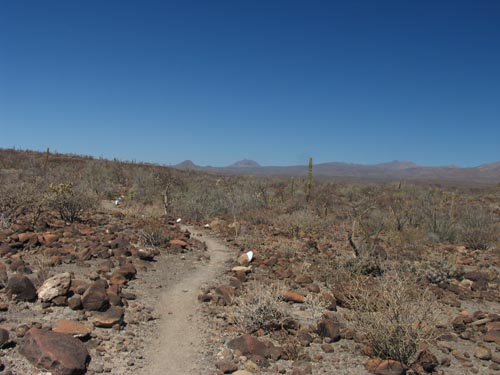8.
At the rock cairn (Los Corralitos trailhead) are Rock Hibiscus, Torote Colorado, Ejotón and a small, unbranched Cardón. Just beyond that junction, in the middle of the Camino Real trail, is a small Ironwood.
 Ejotón and Torote Colorado at the white rock cairn (8)
Ejotón and Torote Colorado at the white rock cairn (8)
 Looking at the Cerro Tepeyac ridge and the many Elephant trees. Foreground is a Cholla Barbona, midground an Organpipe cactus.
Looking at the Cerro Tepeyac ridge and the many Elephant trees. Foreground is a Cholla Barbona, midground an Organpipe cactus.
Along most of the Los Corralitos trail, small treasures can be found growing within the Casa Rata and Hedgehog colonies: Fish Hook cactus and the endemic Pincushion cactus Mammillaria lewisiana. Also nearby: Palo Adán, Limberbush, Vara Prieta, Organpipe and Barrel cactus.
A gigantic, many branched Cardón grows up through the lava flow, perhaps having found its own secret underground water supply.
 View towards Cerro Tepayac and Elephant trees from Los Corralitos
View towards Cerro Tepayac and Elephant trees from Los Corralitos
Looking toward the Tepayac talus slope, the twisted branches of the numerous Torote Colorado can be seen shining in the sunlight.

Heading west from the trailhead (8)

the trail crosses through low vegetation.

Torote colorado on either side of trail.

Cardón with Ejotón in foreground, Torote Colorado at right.

Inconspicuous, a black, crustose lichen grows on rocks in the wash
Across from the cairn, in the
V created by the two trails is a small Vara Prieta.

 Torote Colorado (Bursera microphylla) near marker 9
Torote Colorado (Bursera microphylla) near marker 9
9.
This marker is located within a seasonal watercourse with a solid, lava rock bottom, large boulders and tinajas (rock pools). Note the increased size of the trees and shrubs here because of water; Torotes, Cardón, Ejotón, Mesquite and Ironwood are all supersized.
Look on the rock surfaces for what seems to be a dusting of fuzzy, black paint drops or spray, especially near the bottoms of rocks and in crevices. This crust is lichen, a symbiosis of two organisms, a fungus (the structure) and an alga (the food provider).
In the wash, look also for large shrubs of Euphorbia tomentulosa, Boxthorn and Feather Duster.
Note that as you pass out of the wash, the vegetation becomes lower and sparser and remains so along the rest of this trail.
10.
Up to this junction (with El Atajo), the vegetation has been very low and spread out, with small Limberbush, Palo Adán, and Vara Prieta. Taller plants include Torote Colorado and Desert Ironwood. Cacti include Casa Rata, Pitaya Agria and Hedgehog cactus.
11.
Close to this marker are numerous shrubs of an endemic Ragweed known locally as Chicura (Ambrosia bryantii).

Ironwood (L) and Torote colorado (R)
 Leaving the arroyo and continuing westward.
Leaving the arroyo and continuing westward.
13.
At the vista point, there are many small Barrel and Pincushion cacti among the low-lying Casa Rata, Pitaya Agria and Limberbush.
12.
Casa rata, Cholla Barbona, Palo Adán, Limberbush, Pitaya Agria, Barrel, Fish Hook and Pincushion cacti are all abundant near the corralito. Several Pincushion cacti lurk within the Casa Rata nearby (photo left).

Pitaya agria (L), Ironwood (R)

Limberbush and very low Torote Colorados and Palo Adán dominate along this section.

Casa Rata (
Grusonia invicta)

Colonies of Casa Rata. A Palo Verde on (R)

Casa Rata (rear and left) with small Barrel Cactus
(
Ferocactus peninsulae) at right and Fish-hook cactus (
Mammilliaria dioica) in the foreground.

Pincushion Cactus (
Mammillaria lewisii), a Baja California
endemic that may reach a diameter of 8-9 cm (3-3.5")

Approaching the junction with the El Atajo trail (10)

Chicura is a low, rounded shrub, It may reach about 1 m D.

There may be 5 or more long, slender spines on the
burr (fruit) of the Chicura.
"Hey, don't mess with me!"
 |
ESPAÑOL |
| Trail and Plant Guide:
Mesa del Rincón
San Ignacio, BCS
|
Guide Main | Trail Descriptions | Trail Map | Plant List
TRAILS: El Camino Real | La Vista del Cañon | La Virgen de Guadalupe | Los Corralitos | El Atajo | El Malpaisal | El Arrecife |
Plants by Trail Marker |
| Los Corralitos (click on photos to enlarge) |
 Pincushion Cactus (Mammillaria lewisii), a Baja California
Pincushion Cactus (Mammillaria lewisii), a Baja California 